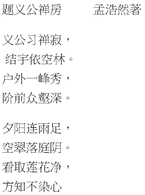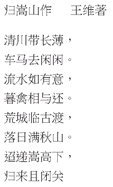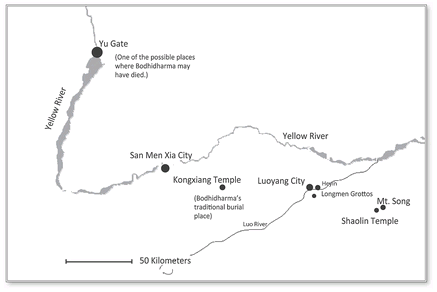Tracking Bodhidharma (41 page)
Read Tracking Bodhidharma Online
Authors: Andy Ferguson

This was not the first time, even in modern history, that war destroyed Changlu Temple. During the Taiping Rebellion that rocked China during the early 1860s, there were wide-ranging battles along the Yang-tse River near Nanjing. Those disturbances also laid waste to the temple. Local records indicate that by the year 1922 efforts to rebuild the temple had succeeded in creating five new halls, with a large amount of money dedicated to installing new Buddhist statues there. Those were the halls and contents destroyed by Japanese troops.
After World War II, no further serious attempts to rebuild the temple occurred, and it later became the site of the middle school that I visited and that Shao attended. Sadly, even what remains of Changlu Temple will soon be gone, making way for new industrial chemical plants planned for the area.
38. Xiangfan City
Yi's quiet meditation hut,
He built beside the empty grove,
Outside its door's a lovely peak,
Midst terraced gullies deeply wove,
He built beside the empty grove,
Outside its door's a lovely peak,
Midst terraced gullies deeply wove,
Â
Full rain poured down throughout the night,
Till an empty garden's moon did find,
A lotus pure which met my sight,
And then I knew unblemished mind.
Till an empty garden's moon did find,
A lotus pure which met my sight,
And then I knew unblemished mind.
â“
On Yi's Zen Meditation Hut” by Meng Haoran (689â740) of Xiangyang (now called Xiangfan) City
On Yi's Zen Meditation Hut” by Meng Haoran (689â740) of Xiangyang (now called Xiangfan) City

LIGHT IN THE HOTEL WINDOW signals that the day has arrived. I peer through the blinds to see that snow is falling and three inches has accumulated on Xiangfan City roofs. The alley I walked last night to reach the hotel is a lake of slush.
The author of the above Chinese poem, Meng Haoran, once lived here. He is among the most famous of the Tang dynasty poets. In his day the city was still called Xiangyang, as it was when Xiao Yan prepared to
topple Emperor Baojuan. I arrived here by bus late last night. The four-hour bus trip from Wuhan to Xiangfan passed without a rest stop, and I arrived in Xiangfan as the sun went down. I lost my hat. I stumbled through the evening rain looking up and down alleys for the little hotel. My throat hurt in the cold. I went to bed after eating some pistachios and a Snickers bar.
topple Emperor Baojuan. I arrived here by bus late last night. The four-hour bus trip from Wuhan to Xiangfan passed without a rest stop, and I arrived in Xiangfan as the sun went down. I lost my hat. I stumbled through the evening rain looking up and down alleys for the little hotel. My throat hurt in the cold. I went to bed after eating some pistachios and a Snickers bar.
Xiangfan (pronounced
Syong-fan
) is one of those huge Chinese cities (population 5.8 million) that almost no one in the West has heard of. It straddles the Han River about two hundred miles upstream and northwest from where that tributary enters the mighty Yang-tse. If Bodhidharma followed the established migration route from Mount Song to Nanjing, then he likely sailed past this city on his way south and maybe again on his return north decades later. Maybe he passed here many times during nearly fifty years of missionary work in China.
Syong-fan
) is one of those huge Chinese cities (population 5.8 million) that almost no one in the West has heard of. It straddles the Han River about two hundred miles upstream and northwest from where that tributary enters the mighty Yang-tse. If Bodhidharma followed the established migration route from Mount Song to Nanjing, then he likely sailed past this city on his way south and maybe again on his return north decades later. Maybe he passed here many times during nearly fifty years of missionary work in China.
After I've had breakfast, a taxi sweeps me through the slushy streets to a bridge that crosses the Han River. The river is far larger than I had imagined it would be, and clearly wide enough to be a major travel and communications route to North China. It could easily accommodate deep-draft vessels. On the far shore I see the wall of the old city, the place where Xiao Yan presided over the area as military governor more than fifteen centuries ago. A few minutes later we pass into the old city area by crossing an ancient moat and then under a traditional Chinese city wall. We weave along a few small lanes, and the driver pulls the car up to the curb.
“That's it,” says the driver. “That's the Zhao Ming Tower.”
A two-story Chinese wooden pavilion sitting atop a four-story brick blockade is visible through the fog and light snow. The driver has parked next to a pedestrian street that runs from the base of the imposing structure toward the river a couple hundred meters to the north. Beneath the Zhao Ming Tower's imposing architecture is a museum of ancient Chinese art and artifacts. Stretching the length of the street in front of it are shops with traditional façades. It's clearly a tourist area when the weather is better.
The Zhao Ming Tower is named after Crown Prince Zhao Ming, the oldest son of Emperor Wu and the author of the poem examined earlier. It rests on the approximate spot where Xiao Yan's governor's office stood a millennium and a half ago. It's also where Zhao Ming was
born, a year or so prior to Xiao Yan's successful overthrow of Baojuan. Although Zhao Ming lived at this spot during only the first year of his life, the city still remembers and honors his illustrious name, keeping it at the center of its old geography and equating it with its past glories.
born, a year or so prior to Xiao Yan's successful overthrow of Baojuan. Although Zhao Ming lived at this spot during only the first year of his life, the city still remembers and honors his illustrious name, keeping it at the center of its old geography and equating it with its past glories.
Exiting the taxi, I point my umbrella into the blowing sleet and head toward the river along the wet pavement. Along the way a few people are buying scarves or mittens at street stalls. A number of people crowd around a man selling bowls of hot noodles. A boy bundled in a blue snowsuit rides on his father's shoulders and looks shocked to see a foreigner walking along behind him.
A passageway through the old wall of the city leads me to the south side of the wide, fast-flowing Han River. Flowing from the north, the river turns east to pass where I am standing on its southern shore and then turns south again. It looks to be a full half mile across.
The area where I'm standing on the bank is a wide pedestrian walkway and park built up several meters above the water. What is immediately obvious is why the old city was situated where I'm standing. Ships swept south on the river's current could take advantage of its turn eastward to easily land on its right bank. Grain barges and other cargos coming from North China would here find an ideal spot to land and unload. Similarly, shipping coming from the south could sail or pole its way along the north shore and then let the current sweep it into the south shore docks. Geography explains a lot.
Because of the same geography, invaders coming from the north would be at a disadvantage, their ships pushed by the bend in the river toward the starboard shore, coming within range of defenders' catapults and crossbows. The city's Web site tells how its strategic position has been the site of innumerable battles for at least three thousand years. It relates that when the Mongolians invaded China in the thirteenth century and fought their way from the north to the south of the country, it took the Great Khan's experienced army two years to overcome this historic spot's excellent defenses.
Clearly, this river was a suitable way for Bodhidharma to make his way south from the region south of Mount Song and sail all the way to Nanjing. This key part of the Bodhidharma puzzle is clear from the size and role of the Han River.
I walk west along the river a short distance and then turn left and
walk south. Soon I reach Sandalwood Road. Local records say that it lies along the area where a large stream, called Sandalwood Creek, once ran. Now nothing remains of that stream due to centuries of floods and silting from the Han River. But the street is still subject to severe flooding if the Han River overflows its banks.
walk south. Soon I reach Sandalwood Road. Local records say that it lies along the area where a large stream, called Sandalwood Creek, once ran. Now nothing remains of that stream due to centuries of floods and silting from the Han River. But the street is still subject to severe flooding if the Han River overflows its banks.
According to Chinese records, Governor Xiao Yan (Wu) secretly laid up stores of wood in that ancient Sandalwood Creek. When he launched his rebellion to overthrow Emperor Baojuan, he used the wood as armor on the grain barges that lined the river, creating troop transports. From here, he led his army down the Han and Yang-tse waterways, the current at his back, to win naval and land victories over Qi dynasty defenders.
Along the same Sandalwood Creek where Xiao Yan hid his timbers there was a Buddhist temple called Gold Virtue Temple. It was established by a famous Buddhist monk named Daoʼan during the fourth century. Dao'an was instrumental in establishing Buddhism in China. He started the Chinese custom of naming Chinese monks with the surname Shi (pronounced
sure
) that designated them as members of the family of Shijiamuni (Shakyamuni), the historical Buddha. He was also instrumental in bringing a famous sutra translator named Kumarajiva to China from Central Asia. When Dao'an lived here in old Xiangyang, he once received a massive amount of copper as a donation to his monastery. With it, he build a sixty-foot statue of Buddha at Gold Virtue Temple, which was somewhere around where I'm walking. This imposing landmark was visible to greet beleaguered migrants that made their way down the river from Northern China. Undoubtedly, most of them stopped to take on provisions as they traveled south. It seems possible, given the timeline of Bodhidharma's possible passage along the river, that Bodhidharma stopped and stayed at that same temple located where I am now. Then it sat aside Emperor Wu's stockpile of war preparations. In any case, if Bodhidharma did indeed teach in the “south and the north” and in the region of “Luoyang and the Yang-tse,” he likely stayed and taught along these banks. Perhaps it was here, even while Xiao Yan was governor of the region, that his followers numbering “like a city” crowded the banks of Sandalwood Creek to hear him speak. It's a narrative worth considering, even if any traces of his life in this area have long been swept away by the Han River's currents.
sure
) that designated them as members of the family of Shijiamuni (Shakyamuni), the historical Buddha. He was also instrumental in bringing a famous sutra translator named Kumarajiva to China from Central Asia. When Dao'an lived here in old Xiangyang, he once received a massive amount of copper as a donation to his monastery. With it, he build a sixty-foot statue of Buddha at Gold Virtue Temple, which was somewhere around where I'm walking. This imposing landmark was visible to greet beleaguered migrants that made their way down the river from Northern China. Undoubtedly, most of them stopped to take on provisions as they traveled south. It seems possible, given the timeline of Bodhidharma's possible passage along the river, that Bodhidharma stopped and stayed at that same temple located where I am now. Then it sat aside Emperor Wu's stockpile of war preparations. In any case, if Bodhidharma did indeed teach in the “south and the north” and in the region of “Luoyang and the Yang-tse,” he likely stayed and taught along these banks. Perhaps it was here, even while Xiao Yan was governor of the region, that his followers numbering “like a city” crowded the banks of Sandalwood Creek to hear him speak. It's a narrative worth considering, even if any traces of his life in this area have long been swept away by the Han River's currents.
39. Mount Song and Shaolin Temple
Beside long reeds and swift clear stream,
My leisured horse and carriage track,
The creek tries to accompany
the flocks in evening winging back,
Old ruins by the river's ford,
Fall's sunset hills illuminate,
Far 'neath Song Mountain's dimming peak,
Arriving home, I close the gate.
My leisured horse and carriage track,
The creek tries to accompany
the flocks in evening winging back,
Old ruins by the river's ford,
Fall's sunset hills illuminate,
Far 'neath Song Mountain's dimming peak,
Arriving home, I close the gate.
â“
Returning to Song Mountain” by Wang Wei (699â759)
Returning to Song Mountain” by Wang Wei (699â759)

LONG BEFORE BUDDHISM arrived in China, the country's ancient Taoist philosophers had designated five sacred mountains in the country. Each mountain sat in one of the five cardinal directions of Taoist cosmology, the north, south, east, west, and the sacred center. Mount Song was the mountain at the middle, the peak of the “central” direction. Westerners don't normally think of the “center” as a direction, but this idea reflects a long-established way of thinking in Chinese culture. The name
China
itself means the “middle kingdom.” In Confucianism, an
important idea is the “doctrine of the center.” Thus when Buddhism came to China advertising itself as a religion of the “middle way,” the idea found receptive ears.
China
itself means the “middle kingdom.” In Confucianism, an
important idea is the “doctrine of the center.” Thus when Buddhism came to China advertising itself as a religion of the “middle way,” the idea found receptive ears.
Â
FIGURE 17. Map of Luoyang/Mount Song Area.

Mount Song is not a single mountain but an area that holds two large mountains and some lesser peaks and valleys. The largest peak, which in Chinese may be called either “Mount Song” or the “Big House,” is said to be where a grand residence of Yu the Great, the first great unifier of China, was located. Legends say that sometime around 2000 BCE, Yu tamed the raging Yellow River by dredging and using dykes. The smaller peak of Mount Song, called “Little House,” is where Yu reportedly set up a smaller residence for his wife's younger sister. From the Chinese term “little house” (
shao shi
) comes the name for Mount Song's most famous temple, Shaolin (meaning “Little Woods”), which was set amid the forest by the Little House Mountain slopes.
shao shi
) comes the name for Mount Song's most famous temple, Shaolin (meaning “Little Woods”), which was set amid the forest by the Little House Mountain slopes.
Not far from Mount Song is the city of Luoyang, a city that served as the capital of many of China's ancient dynasties. From the country's earliest times, emperors came from there to worship the nation's gods on Mount Song's slopes.
Other books
Knowing Vera (Romantic Suspense, Family Drama) (Chance for Love) by Ayala, Rachelle
Keep (Command #2) by Karyn Lawrence
30 Seconds by Chrys Fey
The Last Sacrifice by Sigmund Brouwer
In His Will by Cathy Marie Hake
Dating and Other Dangers by Natalie Anderson
Due Diligence by Michael A Kahn
Under His Domain by Kelly Favor
Get the Truth: Former CIA Officers Teach You How to Persuade Anyone to Tell All by Philip Houston, Michael Floyd, Susan Carnicero
The Grammarian by Annapurna Potluri
